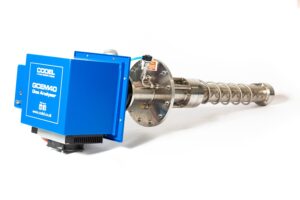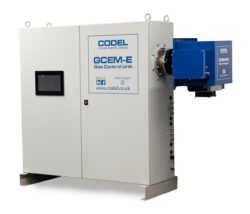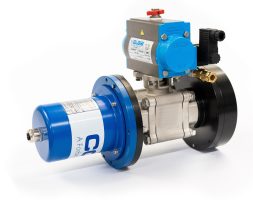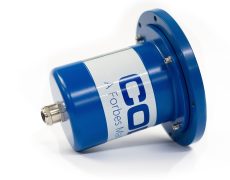CEMS Monitoring (Continuous Emissions Monitoring)
What is Continuous Emissions Monitoring?
Continuous Emissions Monitoring (CEM) involves the ongoing measurement of pollutants released from industrial processes, such as power generation, manufacturing, and waste treatment. CEM systems track harmful gases and particulates in real-time, including common pollutants like sulphur dioxide (SO₂), nitrogen oxides (NOₓ), carbon monoxide (CO), and particulate matter (PM). These systems provide continuous data, ensuring compliance with environmental regulations, promoting air quality, and supporting sustainable practices. By offering a live snapshot of emissions, CEM helps operators take corrective actions promptly to minimize environmental impact.
Our Range of Continuous Emissions Monitors
At CODEL, we provide a wide array of Continuous Emissions Monitoring solutions designed to suit various industrial applications. Our systems utilize state-of-the-art sensors and analysers to measure a range of pollutants in real-time. Whether you need to monitor gases such as CO, NOx, SO₂, or particulate matter, we offer precise, reliable equipment that meets stringent environmental regulations. Our products are engineered to operate efficiently in harsh industrial environments, ensuring accuracy, longevity, and ease of maintenance.
Why Is It Important to Use Continuous Emissions Monitors?
Continuous Emissions Monitors are essential for several reasons:
Regulatory Compliance: Many industries are required by law to monitor and report their emissions to ensure compliance with environmental regulations. CEM systems provide the necessary data to meet legal standards and avoid penalties.
Environmental Protection: By providing real-time emissions data, CEMs enable businesses to manage and reduce their environmental impact, particularly in terms of air pollution. They help mitigate harmful emissions like NOx and SO₂ that contribute to acid rain, smog, and health issues.
Operational Efficiency: Continuous monitoring allows for the early detection of process inefficiencies, enabling operators to adjust operations and optimize performance. This reduces waste, improves energy efficiency, and minimizes downtime.
Health and Safety: CEM systems help protect workers and nearby communities by providing immediate alerts in the event of dangerous emissions levels. This enhances safety and reduces the risk of health issues related to exposure to hazardous pollutants.
Why Choose CODEL's Products for Continuous Emissions Monitoring?
CODEL offers industry-leading Continuous Emissions Monitoring solutions that deliver unparalleled accuracy, reliability, and ease of use. Here’s why you should choose CODEL:
Advanced Technology: Our monitors utilize cutting-edge technology, such as optical sensors and electrochemical analysers, to ensure accurate real-time emissions data.
Customization: We offer tailored solutions for a variety of industries, ensuring our products meet your specific monitoring needs. Whether it’s for power plants, manufacturing facilities, or waste management, our systems are designed to fit seamlessly into your operation.
Compliance Support: CODEL’s monitors help you meet stringent environmental regulations and ensure compliance with industry standards, protecting both the environment and your company from potential fines.
Low Maintenance and Long Life: Our systems are built for durability, with minimal maintenance required. This reduces operational downtime and lowers the total cost of ownership.
Real-Time Alerts: With real-time monitoring and alerts, our systems enable you to take immediate action if emission levels exceed safe limits, enhancing safety and reducing risks.
Expert Support: We provide exceptional customer service, from installation to ongoing maintenance, ensuring your monitoring systems continue to perform optimally. Our experienced team is always ready to assist with troubleshooting and optimizing performance.
By choosing CODEL, you are investing in a reliable, high-quality solution that not only ensures regulatory compliance but also supports your sustainability goals and improves operational efficiency.
Our Range of Continuous Emissions Monitors Include:
The GCEM40 analyser is an in-situ device which is cost-effective, low maintenance and designed both for process control and emissions monitoring.
CO, NOx, SO2, HCl, CH4, CO2 & H2O
The GCEM40E hot extractive multi-channel gas analyser is CODEL’s industry-proven continuous emissions monitor for difficult applications
CO, NOx, SO2, HCl, CH4, CO2 & H2O
The DCEM2100 is a dual-pass transmissometer configured for the continuous measurement of opacity and dust concentration in flue gases.
CODEL’s unique flow monitors measure the velocity of stack gases using a highly accurate time of flight measurement that is derived from a cross correlation analysis of the infra-red emissions of the turbulent gas.
Gas Flow
Ask a question
For further information on any of our products, please complete our enquiry form and a member of staff will respond as soon as possible.
You can also call: +44(0)1629 814351





